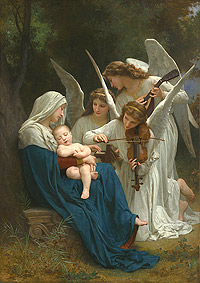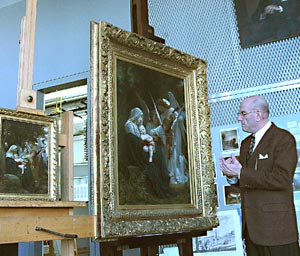 |


 |
 |
Virgin of the Angels, Adolphe-William Bouguereau, 1881
Courtesy of Forest Lawn Memorial-Park Association |
|
Four works by Adolphe-William Bouguereau, one of the most popular and controversial artists of the 19th century, were on display at the Getty Center, West Pavilion, through June 15, 2006. The installation featured the Getty's Young Girl Defending Herself Against Eros and three versions of Virgin of the Angels (right).
A preparatory sketch and a half-size replica of Virgin of the Angels from Bouguereau's own hand hung alongside the life-size original, one of the most important paintings by Bouguereau in the United States.
The painting came to the Getty from the Forest Lawn Museum in Glendale as part of the Getty Museum's Conservation Partnership Program, which conserves paintings free of charge in exchange for the opportunity to share them with Getty Center visitors.
Who Was Bouguereau?
Adolphe-William Bouguereau [boo-ger-OH] was the most popular French artist of the late 1800s. Crowds thronged the annual Salon to see his latest canvases, and the wealthy clamored to purchase them for enormous sums.
|
 |
 |

 |
 |
"You either like Bouguereau or you think he's the most abhorrent artist who ever lived," says Scott Schaefer, standing in the paintings conservation studio
 |
But as the public cheered, critics booed. They derided the "bourgeois finickiness" and "contagious mediocrity" of Bouguereau's mirror-smooth, romanticized paintings of cupids, nudes, and peasant girls.
To some, Bouguereau's flawless technique, graceful compositions, and poignant portraits make him one of the most accomplished artists of his age. To others, the artist represents everything negative about 19th-century academic art, with its stock characters, syrupy emotion, and social and artistic conservatism. "You either like Bouguereau or you think he's the most abhorrent artist who ever lived," says paintings curator Scott Schaefer.
"A Masterful Technician"
But critics and admirers agree: Bouguereau was a remarkably skilled painter. "He was a masterful technician," says paintings conservator Mark Leonard, who worked with Schaefer to bring the loans to the Getty. "He had an incredible ability to manipulate paint, and I admire him." Leonard spent months studying, cleaning, and restoring the life-size version of Virgin of the Angels and its replica. He removed the old varnish that was dirtying the angels' wings and yellowing Mary's blue cloak, revealing the clarity of the original colors (see images below).
|
 |
|
The cleaning also revealed how precisely the smaller replica mirrors the larger original—even down to the number of brushstrokes. It was common for 19th-century artists to make replicas of their successful compositions; the Getty's Young Girl Defending Herself Against Eros (below right) is itself a replica of a larger painting. But the precision of Bouguereau's replicas is unique, and experts are still not sure exactly how he created them.
Replicas were economical for Bouguereau to produce because they sold well and spared him the labor of creating a new composition. The artist planned his paintings in painstaking detail, sketching the composition in oil and making detailed drawings of each figure before committing to a final design. Once he began painting, he allowed few changes. X-rays of Virgin of the Angels reveal almost no changes or corrections; the artist only shifted the position of a few pegs on the violin played by the angel at the center.
This technical perfection was foreign to the sensibility of younger artists such as the Impressionists, who shocked Bouguereau's public with their spontaneous technique and visible brushstrokes. The installation lets us compare Bouguereau's paintings to one another and to those of his more avant-garde contemporaries Claude Monet, Vincent van Gogh, and Paul Cézanne, which are displayed in the adjoining gallery.
"Bouguereau is not a painter of modern life like Manet and Monet—his art wasn't meant to be challenging or difficult," concludes Schaefer. "Having these works all together is like having a great big dinner party. I'm curious to see how people react."
This installation was located at the Getty Center, Museum, West Pavilion.
|
|
 |
|